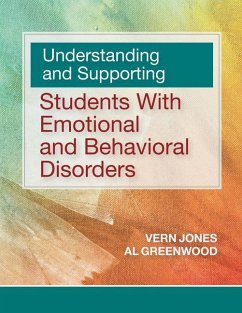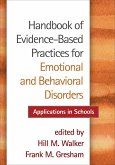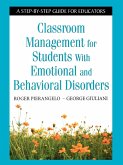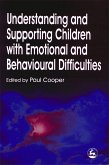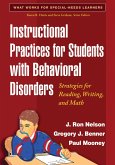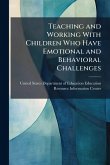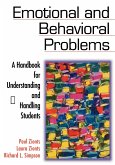Vern Jones, Al William Greenwood
Understanding and Supporting Students with Emotional and Behavioral Disorders
Vern Jones, Al William Greenwood
Understanding and Supporting Students with Emotional and Behavioral Disorders
- Broschiertes Buch
- Merkliste
- Auf die Merkliste
- Bewerten Bewerten
- Teilen
- Produkt teilen
- Produkterinnerung
- Produkterinnerung
Provides pre-service special educators, school psychologists, school administrators, and behaviour specialists with a solid understanding of the key issues associated with providing support for students with EBD. The book further provides highly practical methods for working effectively with these students in a variety of settings.
Andere Kunden interessierten sich auch für
![Handbook of Evidence-Based Practices for Emotional and Behavioral Disorders Handbook of Evidence-Based Practices for Emotional and Behavioral Disorders]() Handbook of Evidence-Based Practices for Emotional and Behavioral Disorders65,99 €
Handbook of Evidence-Based Practices for Emotional and Behavioral Disorders65,99 €![Classroom Management for Students with Emotional and Behavioral Disorders Classroom Management for Students with Emotional and Behavioral Disorders]() Roger PierangeloClassroom Management for Students with Emotional and Behavioral Disorders29,99 €
Roger PierangeloClassroom Management for Students with Emotional and Behavioral Disorders29,99 €![Understanding and Supporting Children with Emotional and Behavioral Difficulties Understanding and Supporting Children with Emotional and Behavioral Difficulties]() Understanding and Supporting Children with Emotional and Behavioral Difficulties42,99 €
Understanding and Supporting Children with Emotional and Behavioral Difficulties42,99 €![Instructional Practices for Students with Behavioral Disorders Instructional Practices for Students with Behavioral Disorders]() J Ron NelsonInstructional Practices for Students with Behavioral Disorders31,99 €
J Ron NelsonInstructional Practices for Students with Behavioral Disorders31,99 €![Teaching and Working With Children Who Have Emotional and Behavioral Challenges Teaching and Working With Children Who Have Emotional and Behavioral Challenges]() Teaching and Working With Children Who Have Emotional and Behavioral Challenges15,99 €
Teaching and Working With Children Who Have Emotional and Behavioral Challenges15,99 €![Emotional and Behavioral Problems Emotional and Behavioral Problems]() Paul ZiontsEmotional and Behavioral Problems39,99 €
Paul ZiontsEmotional and Behavioral Problems39,99 €![Supporting Pupils with Autistic Spectrum Disorders Supporting Pupils with Autistic Spectrum Disorders]() Lynn PlimleySupporting Pupils with Autistic Spectrum Disorders48,99 €
Lynn PlimleySupporting Pupils with Autistic Spectrum Disorders48,99 €-
-
-
Provides pre-service special educators, school psychologists, school administrators, and behaviour specialists with a solid understanding of the key issues associated with providing support for students with EBD. The book further provides highly practical methods for working effectively with these students in a variety of settings.
Produktdetails
- Produktdetails
- Verlag: Brookes Publishing Company
- Seitenzahl: 444
- Erscheinungstermin: 17. Februar 2022
- Englisch
- Abmessung: 295mm x 224mm x 30mm
- Gewicht: 408g
- ISBN-13: 9781681255743
- ISBN-10: 168125574X
- Artikelnr.: 62889380
- Herstellerkennzeichnung
- Libri GmbH
- Europaallee 1
- 36244 Bad Hersfeld
- gpsr@libri.de
- Verlag: Brookes Publishing Company
- Seitenzahl: 444
- Erscheinungstermin: 17. Februar 2022
- Englisch
- Abmessung: 295mm x 224mm x 30mm
- Gewicht: 408g
- ISBN-13: 9781681255743
- ISBN-10: 168125574X
- Artikelnr.: 62889380
- Herstellerkennzeichnung
- Libri GmbH
- Europaallee 1
- 36244 Bad Hersfeld
- gpsr@libri.de
Dr. Jones has been a junior high school teacher of students with EBD, a junior high school vice principal, and a district coordinator for students with EBD. He has consulted with university faculty, state departments of education, school districts, and educators in over 25 states in the areas of classroom management, programs and individual interventions for students with EBD, and school violence prevention. Dr. Jones is Emeritus Professor of Education at Lewis & Clark College in Portland, Oregon where he was chair of the education and special education departments in the Graduate School of Education and Counseling. His books include Comprehensive Classroom Management, 12th Ed. (2021), Effective Supports for Students with Emotional and Behavioral Disorders, (2016), Practical Classroom Management 2nd Ed. (2015), Creating Effective Programs for Students with Emotional and Behavior Discipline (2004), Responsible School Discipline (1981), and Adolescents with Behavior Problems, (1980). He was selected by the National Association of Colleges of Teacher Education to write the chapter on classroom management for the Handbook of Research on Teacher Education (1996) and wrote the chapter "How Do Teachers Learn to Be Effective Classroom Managers?" for the Handbook for Classroom Management: Research, Practice, and Contemporary Issues (2006). Dr. Greenwood is a licensed Clinical Psychologist. Dr. Greenwood spent the first 10 years of his career at Good Samaritan Hospital in Portland, Oregon working with children having complex neurodevelopmental, learning and behavior challenges. Since 1989 he has been an independent practitioner providing support to children with EBD and their families and has been actively engaged as a special programs consultant to school districts and education service districts. Dr. Greenwood has conducted numerous trainings and workshops on the BSP process and supportive interventions for students experiencing EBD. He is often called upon to be an independent evaluator in special education litigation. For over 20 years Dr. Greenwood was also an adjunct professor in the Graduate School of Education and Counseling at Lewis & Clark College in Portland, Oregon. He currently consults with school districts on special education issues, program development, and best practice methods for supporting students with emotional and behavioral disorders. He is also co-founder of 321 Insight, a web-based company providing training and support for educators.
1. About the Online Materials
2. About the Authors
3. Preface
4. Acknowledgments
5. Dedication
6. Chapter 1: Key Concepts and Assumptions Related To Effective Support For
Students With Emotional And Behavioral Disorders
7. Services and Levels of Success for Students With EBD
8. Key Assumptions Underlying Effective Support for Students Experiencing EBD
9. Case Study
10. Summary
11. References
12. Chapter 2: Developing A Foundational Understanding of Emotional and
Behavioral Disorders
13. Appreciate the Complex Nature of Behavior Associated With EBD
14. Develop Accurate Conceptualizations
15. Utilize a Developmental Perspective
16. Be Knowledgeable About Risk and Protective Factors
17. Recognize Key Skill Deficits and Unique Characteristics of Students With
EBD
18. Use Methods and Practices That Facilitate Effective Supports
19. Understand and Utilize Mental Health Systems and Perspectives
20. Summary
21. References
22. Chapter 3: Creating Supportive Adult–Student and Peer Relationships
23. The Importance of Adult–Student Relationships in Supporting Students With
EBD
24. Creating Supportive Peer Relationships in the Classroom
25. Developing Supportive Relationships With Caregivers
26. Summary
27. References
28. Chapter 4: Developing Behavior Standards and Increasing Students’
Motivation to Learn
29.
* Developing Clear and Effective General Classroom Behavior Standards
and Procedures
* Increasing Students’ Motivation to Learn and Enhancing Their Academic
Success
* Summary
* References
* Chapter 5: Responding Effectively to Disruptive Behavior
* Methods for Responding Effectively to Disruptive or Defiant Behavior
* Responding to Violent Student Behavior
* Creating an Effective Classroom Discipline Procedure
* Incorporating Social Problem Solving Into the Classroom and School
Discipline System
* Disciplinary Exclusion for Students Identified as EBD
* Summary
* References
* Chapter 6: Developing Individualized Behavior Support Plans: Planning
for Student Success
* Understanding the Behavior Support Plan Process
* Components of the BSP Process
* Implementing the BSP Across a Continuum of Services
* Increasing the Effectiveness of the BSP
* Summary
* References
* Chapter 7: Social-Emotional Learning Methods for Supporting Student
Success
* Understanding Social-Emotional Learning
* Methods and Strategies for Developing Self-Regulation
* Facilitating Self-Awareness and Understanding School Behavior Skills:
Learning and Demonstrating Behaviors That Are Adaptive and Socially
Acceptable in a School Setting
* Using Systematic Desensitization and Cognitive Restructuring to
Assist Students in Adjusting to Stressful Situations
* Summary
* References
* Chapter 8: Developing an Effective Program for Students Identified as
EBD
* Components of an Effective Specialized Program for Students
Identified as EBD
* Ensuring Program Quality
* Summary
* References
2. About the Authors
3. Preface
4. Acknowledgments
5. Dedication
6. Chapter 1: Key Concepts and Assumptions Related To Effective Support For
Students With Emotional And Behavioral Disorders
7. Services and Levels of Success for Students With EBD
8. Key Assumptions Underlying Effective Support for Students Experiencing EBD
9. Case Study
10. Summary
11. References
12. Chapter 2: Developing A Foundational Understanding of Emotional and
Behavioral Disorders
13. Appreciate the Complex Nature of Behavior Associated With EBD
14. Develop Accurate Conceptualizations
15. Utilize a Developmental Perspective
16. Be Knowledgeable About Risk and Protective Factors
17. Recognize Key Skill Deficits and Unique Characteristics of Students With
EBD
18. Use Methods and Practices That Facilitate Effective Supports
19. Understand and Utilize Mental Health Systems and Perspectives
20. Summary
21. References
22. Chapter 3: Creating Supportive Adult–Student and Peer Relationships
23. The Importance of Adult–Student Relationships in Supporting Students With
EBD
24. Creating Supportive Peer Relationships in the Classroom
25. Developing Supportive Relationships With Caregivers
26. Summary
27. References
28. Chapter 4: Developing Behavior Standards and Increasing Students’
Motivation to Learn
29.
* Developing Clear and Effective General Classroom Behavior Standards
and Procedures
* Increasing Students’ Motivation to Learn and Enhancing Their Academic
Success
* Summary
* References
* Chapter 5: Responding Effectively to Disruptive Behavior
* Methods for Responding Effectively to Disruptive or Defiant Behavior
* Responding to Violent Student Behavior
* Creating an Effective Classroom Discipline Procedure
* Incorporating Social Problem Solving Into the Classroom and School
Discipline System
* Disciplinary Exclusion for Students Identified as EBD
* Summary
* References
* Chapter 6: Developing Individualized Behavior Support Plans: Planning
for Student Success
* Understanding the Behavior Support Plan Process
* Components of the BSP Process
* Implementing the BSP Across a Continuum of Services
* Increasing the Effectiveness of the BSP
* Summary
* References
* Chapter 7: Social-Emotional Learning Methods for Supporting Student
Success
* Understanding Social-Emotional Learning
* Methods and Strategies for Developing Self-Regulation
* Facilitating Self-Awareness and Understanding School Behavior Skills:
Learning and Demonstrating Behaviors That Are Adaptive and Socially
Acceptable in a School Setting
* Using Systematic Desensitization and Cognitive Restructuring to
Assist Students in Adjusting to Stressful Situations
* Summary
* References
* Chapter 8: Developing an Effective Program for Students Identified as
EBD
* Components of an Effective Specialized Program for Students
Identified as EBD
* Ensuring Program Quality
* Summary
* References
1. About the Online Materials
2. About the Authors
3. Preface
4. Acknowledgments
5. Dedication
6. Chapter 1: Key Concepts and Assumptions Related To Effective Support For
Students With Emotional And Behavioral Disorders
7. Services and Levels of Success for Students With EBD
8. Key Assumptions Underlying Effective Support for Students Experiencing EBD
9. Case Study
10. Summary
11. References
12. Chapter 2: Developing A Foundational Understanding of Emotional and
Behavioral Disorders
13. Appreciate the Complex Nature of Behavior Associated With EBD
14. Develop Accurate Conceptualizations
15. Utilize a Developmental Perspective
16. Be Knowledgeable About Risk and Protective Factors
17. Recognize Key Skill Deficits and Unique Characteristics of Students With
EBD
18. Use Methods and Practices That Facilitate Effective Supports
19. Understand and Utilize Mental Health Systems and Perspectives
20. Summary
21. References
22. Chapter 3: Creating Supportive Adult–Student and Peer Relationships
23. The Importance of Adult–Student Relationships in Supporting Students With
EBD
24. Creating Supportive Peer Relationships in the Classroom
25. Developing Supportive Relationships With Caregivers
26. Summary
27. References
28. Chapter 4: Developing Behavior Standards and Increasing Students’
Motivation to Learn
29.
* Developing Clear and Effective General Classroom Behavior Standards
and Procedures
* Increasing Students’ Motivation to Learn and Enhancing Their Academic
Success
* Summary
* References
* Chapter 5: Responding Effectively to Disruptive Behavior
* Methods for Responding Effectively to Disruptive or Defiant Behavior
* Responding to Violent Student Behavior
* Creating an Effective Classroom Discipline Procedure
* Incorporating Social Problem Solving Into the Classroom and School
Discipline System
* Disciplinary Exclusion for Students Identified as EBD
* Summary
* References
* Chapter 6: Developing Individualized Behavior Support Plans: Planning
for Student Success
* Understanding the Behavior Support Plan Process
* Components of the BSP Process
* Implementing the BSP Across a Continuum of Services
* Increasing the Effectiveness of the BSP
* Summary
* References
* Chapter 7: Social-Emotional Learning Methods for Supporting Student
Success
* Understanding Social-Emotional Learning
* Methods and Strategies for Developing Self-Regulation
* Facilitating Self-Awareness and Understanding School Behavior Skills:
Learning and Demonstrating Behaviors That Are Adaptive and Socially
Acceptable in a School Setting
* Using Systematic Desensitization and Cognitive Restructuring to
Assist Students in Adjusting to Stressful Situations
* Summary
* References
* Chapter 8: Developing an Effective Program for Students Identified as
EBD
* Components of an Effective Specialized Program for Students
Identified as EBD
* Ensuring Program Quality
* Summary
* References
2. About the Authors
3. Preface
4. Acknowledgments
5. Dedication
6. Chapter 1: Key Concepts and Assumptions Related To Effective Support For
Students With Emotional And Behavioral Disorders
7. Services and Levels of Success for Students With EBD
8. Key Assumptions Underlying Effective Support for Students Experiencing EBD
9. Case Study
10. Summary
11. References
12. Chapter 2: Developing A Foundational Understanding of Emotional and
Behavioral Disorders
13. Appreciate the Complex Nature of Behavior Associated With EBD
14. Develop Accurate Conceptualizations
15. Utilize a Developmental Perspective
16. Be Knowledgeable About Risk and Protective Factors
17. Recognize Key Skill Deficits and Unique Characteristics of Students With
EBD
18. Use Methods and Practices That Facilitate Effective Supports
19. Understand and Utilize Mental Health Systems and Perspectives
20. Summary
21. References
22. Chapter 3: Creating Supportive Adult–Student and Peer Relationships
23. The Importance of Adult–Student Relationships in Supporting Students With
EBD
24. Creating Supportive Peer Relationships in the Classroom
25. Developing Supportive Relationships With Caregivers
26. Summary
27. References
28. Chapter 4: Developing Behavior Standards and Increasing Students’
Motivation to Learn
29.
* Developing Clear and Effective General Classroom Behavior Standards
and Procedures
* Increasing Students’ Motivation to Learn and Enhancing Their Academic
Success
* Summary
* References
* Chapter 5: Responding Effectively to Disruptive Behavior
* Methods for Responding Effectively to Disruptive or Defiant Behavior
* Responding to Violent Student Behavior
* Creating an Effective Classroom Discipline Procedure
* Incorporating Social Problem Solving Into the Classroom and School
Discipline System
* Disciplinary Exclusion for Students Identified as EBD
* Summary
* References
* Chapter 6: Developing Individualized Behavior Support Plans: Planning
for Student Success
* Understanding the Behavior Support Plan Process
* Components of the BSP Process
* Implementing the BSP Across a Continuum of Services
* Increasing the Effectiveness of the BSP
* Summary
* References
* Chapter 7: Social-Emotional Learning Methods for Supporting Student
Success
* Understanding Social-Emotional Learning
* Methods and Strategies for Developing Self-Regulation
* Facilitating Self-Awareness and Understanding School Behavior Skills:
Learning and Demonstrating Behaviors That Are Adaptive and Socially
Acceptable in a School Setting
* Using Systematic Desensitization and Cognitive Restructuring to
Assist Students in Adjusting to Stressful Situations
* Summary
* References
* Chapter 8: Developing an Effective Program for Students Identified as
EBD
* Components of an Effective Specialized Program for Students
Identified as EBD
* Ensuring Program Quality
* Summary
* References

